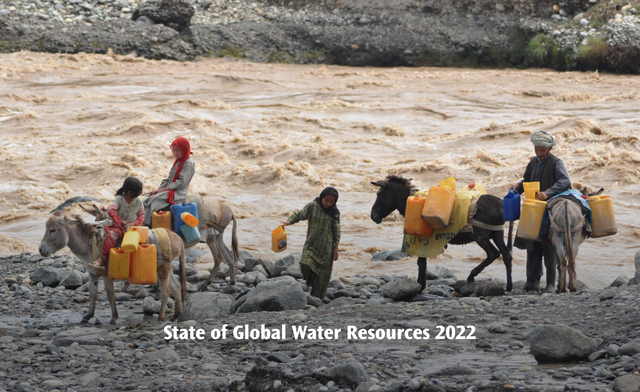Anne-Lise Hadzopoulos
On 12 October 2023, the World Meteorological Organization (WMO) launched the second State of Global Water Resources 2022 report. The secretary general of the WMO, Peter Taalas, introduced the report as a compilation of data on hydrological cycle changes, which serve to inform climate adaptation, mitigation and water management policy. The WMO collaborated with 14 member countries and a vast network of hydrological experts as well as organizations such as NASA and the German Research Centre for Geosciences (GFZ) to compile a detailed analysis of 7 hydrological variables, including precipitation patterns, river discharge, groundwater levels, evaporation rates, soil moisture, inflow to reservoirs, and the status of the cryosphere.
Key Findings: Unveiling the Changing Face of Our Water Resources
The report underscores the far-reaching implications of climate change and human interference on hydrological cycles, the cryosphere, and water-related disasters worldwide. Key findings include:
- Water Reservoir Challenges: More than 60% of major water reservoirs witnessed below or normal inflow. This creates a significant challenge for ensuring a stable water supply to all users, particularly in the face of an increasingly variable climate.
- Cryosphere Changes: The region encompassing the Tibetan Plateau and surrounding mountains plays a crucial role in providing water to nearly 2 billion people. However, from 2000 to 2018, total glacier mass balance in this region decreased by more than 4%. Snow cover decreased significantly, and the volume of glacial lakes increased, which has had a noticeable impact on river runoffs in the Indus, Amu Darya, Yangtze, and Yellow River basins.
- South American Drought: The La Plata river basin in South America experienced drought conditions since 2020, leading to a significant drop in hydropower production and instances of water supply shortages in Paraguay in 2022.
- Indus River Mega Flood: A mega flood struck the Indus River Basin in Pakistan, causing significant casualties, affecting millions, and resulting in massive economic losses exceeding $30 billion. The flood was fuelled by a combination of increased glacier meltwater, severe monsoon rainfall, and an early-year heatwave.
The incidence of the Report on member countries' policy making
During the launch, two member countries representatives, the Ambassador of Indonesia, Mr Achsanul Habib, and the ambassador of Costa-Rica, Mr Christian Guillermet Fernández, expressed the expected benefits of the annual publication of the report for collaborating nations.
Ambassador Habib acknowledged the importance of such studies for Indonesia, a country where 260 million civilians are affected by waterflows as it is composed by over 17 000 islands. He highlighted that adequate access to water has been a recurring challenge as the country faces demographic increases and lack of adequate infrastructure and resources. Notably, water-related disasters such as floods and droughts affect food security and economic development. The Indonesian government struggles to prevent and plan for these weather events because of lack of available data and coverage of monitoring in Indonesian basins. Hence the need for an authoritative publication to inform policy about the status of basins in Indonesia.
Ambassador Guillermet Fernández, described the national context of his country which is characterized by a great coverage of access to water, and a dependence to hydrological energy production. He highlighted the necessity to recognize access to water as a basic human-right and a necessary pre-condition to maintain security. Hence, the importance to keep civil society's participation as a priority as water is a common good. In this light, the WMO's report is essential informing policy as it provides points of comparison to monitor the progress of water cycles throughout time. Additionally, he voiced his hope to see this report act as a catalyser for international cooperation in both data collection and monitoring as well as transboundary water management policies. Given the international nature of water bodies and the impact of national water flows such as rivers on international waters, he called for an international holistic approach to water management that takes into account biodiversity, human rights, security and economic development.
Challenges and Progress
The lack of data and disparities in available data represent the greatest challenge to climate mitigation and adaptation policies. In most places, particularly in the Global South, quality data collection in hydrological variables is scarce, and coverage of basin monitoring is insufficient. There are great disparities in the monitoring of hydrological resources between developing countries and their counterparts. It is crucial to bridge this knowledge gap as the Global South is the most vulnerable to climate change and water-related disaster events.
As a response to these cognitive challenges, the WMO leads several projects as part of the Early Warning for All initiative. Early Warning for All is a project where governments, civil society, and development partners across the public and private sectors collaborate with the broader UN system to address gaps and enhance early warning systems that leave no one behind. The WMO also such addresses challenges by monitoring the coverage of its members through surveys and writing reports such as "State of Global Water Resources 2022".
The "State of Global Water Resources 2022" report exhibits remarkable advancements in its coverage and data quality compared to the 2021 edition. The 2022 report encompasses data from 14 countries, doubling the number from the previous year. Moreover, the report transitions from analyzing only two hydrological variables to seven, allowing for a more detailed and holistic assessment of water resources. This progression also entails a shift from relying on 38 monitoring stations to 273.
These improvements not only enhance the breadth and depth of the report's insights but also underscore its critical role in guiding informed decisions and policies for sustainable water resource management on a global scale. This report contributes to the essential transmission of scientific knowledge from hydrological experts to policymakers necessary to reach climate targets. The report will be published annually and distributed to members of the upcoming UNFCCC COP28 in Dubai and to attendants of the 10th World Water Forum in Bali in 2024.


